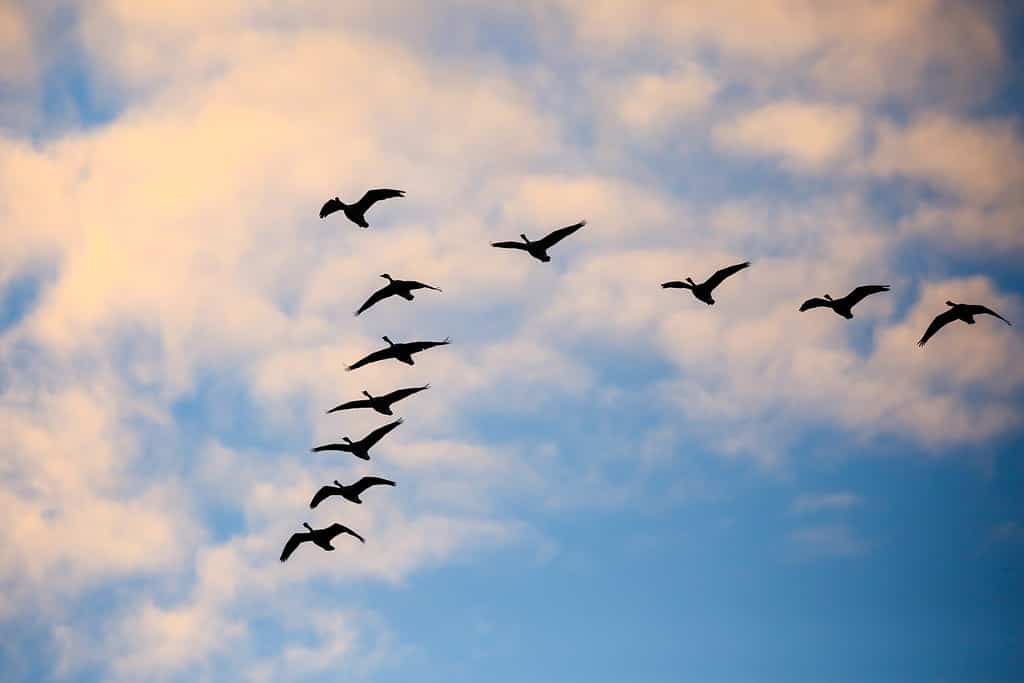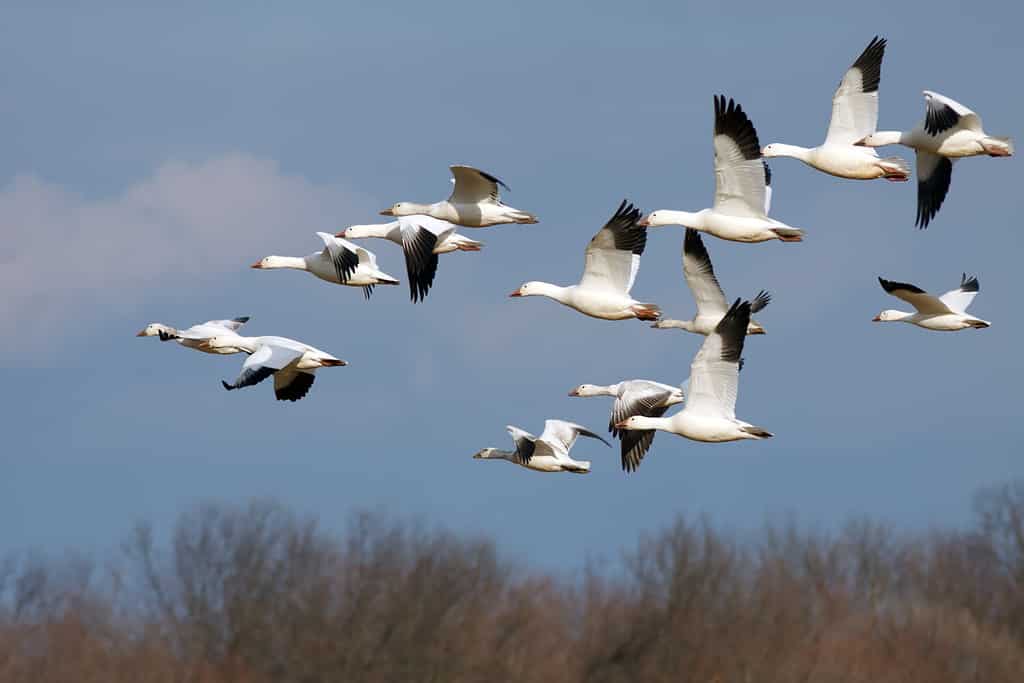Have you ever noticed that geese fly in a V formation during migration? If so, you may have wondered just why flocks of geese perform this curious behavior. Below, learn just why this V formation is critical to a successful migration. Plus, learn how geese know where they are going and whether all species of geese fly like this.
Why Do Geese Fly in a V Formation?
There are a variety of shapes that geese can fly in. From straight lines to circles to haphazard flocks, it may seem like there are plenty of other formations for geese to choose from other than V. So why do they choose this formation?
As it turns out, there are several benefits to this particular arrangement.

There are many benefits to flying in a V formation.
©Michael Tatman/Shutterstock.com
Energy Conservation
One of the number one benefits of geese flying in a V formation is the conservation of energy. When birds fly, they are actively fighting physical forces. Gravity works to pull objects, or geese, towards the center of the Earth. Air resistance, or drag, is a force that works in opposition to the motion of an object in the air. For example, when someone skydives with a parachute, gravity pulls the person to the ground, and white resistance acts in the parachute. For a goose in flight moving forward, gravity attempts to pull them to Earth while drag pulls backward in an attempt to slow them.
But what does this have to do with why geese fly in a V formation?
When geese fly in a V shape, they do so in a very specific way. You see, each bird in the V isn’t flying equal to one another. Instead, each bird flies ever so slightly above the bird in front of them. Because of this, they face less drag than birds at the front of the shape. Each goose will take a turn leading the formation. Then, as they grow tired, they move to the back of the V, where it takes less energy to fly. By the time
This efficiency is what allows for geese to fly so far with little to no rest.
Communication and Coordination
Energy conservation isn’t the only benefit of flying in a V formation, however. If you’ve ever seen fighter pilots in action, you’ll notice that they also fly in a V formation. This is because this arrangement allows for visual assurance. When geese fly this way, they are able to track each and every one of their flock members. They can also communicate more easily.
How Do Geese Know Where They Are Going?
Now that you know more about why geese fly in a V formation, you may be wondering how they know where to fly. Believe it or not, geese possess several different mental and physical adaptations that allow them to navigate.
First, geese are able to navigate based on experience. Adults will fly with their young, helping to engrain the route in mind. Then, they are able to use natural landmarks, like rivers, to guide them on this familiar path. Furthermore, they are able to navigate in a way much like that of early travelers: using the stars and sun.
However, what is most interesting is the protein in a goose’s eyes. This specialized protein allows them to “see” the Earth’s magnetic field — an interesting development to the previous belief that iron in the bird’s beaks acted as a natural compass. Science is always changing, however, and without the ability to see through a bird’s eye view, we may never know exactly how they perceive the world around them. However, these studies have been highly beneficial in better understanding a bird’s life.
So, to summarize, geese are highly aware of the routes they are traveling. Not only do they have their memories of traveling familiar paths, much like driving to your favorite store or place, but they also have a built-in GPS that helps them navigate.

Some species of geese can travel thousands of miles.
©Delmas Lehman/Shutterstock.com
Do All Geese Species Fly in a V Formation?
Chances are, if you’re located in North America, and you’ve seen birds flying in a V formation, it has likely been Canada geese (Branta canadensis). However, Canada geese aren’t the only species to fly in a V formation. In fact, geese as a whole aren’t the only birds to fly in this arrangement. Instead, you’re also likely to see certain species of ducks or swans flying in a V formation.
Pelicans and ibises may also fly in a V formation when they decide to flock together. However, they may also travel alone or in smaller groups when such an arrangement isn’t possible — or unneeded, such as in the case of traveling short distances.

Ducks and swans also travel in V formations, just like geese.
©Olexandr Panchenko/Shutterstock.com
The photo featured at the top of this post is © Volodymyr Burdiak/Shutterstock.com
Thank you for reading! Have some feedback for us? Contact the AZ Animals editorial team.







